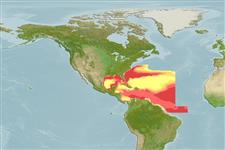Elasmobranchii (sharks and rays) >
Carcharhiniformes (Ground sharks) >
Triakidae (Houndsharks) > Triakinae
Etymology: Mustelus: Latin for weasel, an ancient name for sharks, possibly referring to the pointed snouts, swift movements and/or rapacious feeding behavior of smaller predatory sharks [strictly not tautonymous with Squalus mustelus Linnaeus 1758 since type was designated by the ICZN] (See ETYFish); sinusmexicanus: -anus, Latin adjectival suffix that means, when attached to a name, “belonging to”: sinus, Latin for bay or gulf, referring to the Gulf of Mexico, type locality (See ETYFish).
Environment: milieu / climate zone / depth range / distribution range
Ecology
Marine; pelagic-oceanic; depth range 20 - 250 m (Ref. 55584), usually 42 - 91 m (Ref. 55584). Tropical
Western Central Atlantic: apparently endemic to the Gulf of Mexico, from off Panama City, Florida to the Bay of Campeche.
Size / Weight / Age
Maturity: Lm ? range ? - ? cm
Max length : 83.0 cm TL male/unsexed; (Ref. 27770); 140.0 cm TL (female)
Ovoviviparous (Ref. 50449).
Life cycle and mating behavior
Maturity | Reproduction | Spawning | Eggs | Fecundity | Larvae
Ovoviviparous, embryos feed solely on yolk (Ref. 50449). Distinct pairing with embrace (Ref. 205).
Heemstra, P.C., 1997. A review of the smooth-hound sharks (Genus Mustelus, Family Triakidae) of the western Atlantic ocean, with descriptions of two new species and a new subspecies. Bull. Mar. Sci. 60(3):894-928. (Ref. 27770)
IUCN Red List Status (Ref. 130435: Version 2024-1)
Threat to humans
Harmless
Human uses
Tools
Special reports
Download XML
Internet sources
Estimates based on models
Preferred temperature (Ref.
123201): 20.4 - 27.2, mean 24.5 °C (based on 103 cells).
Phylogenetic diversity index (Ref.
82804): PD
50 = 0.5000 [Uniqueness, from 0.5 = low to 2.0 = high].
Bayesian length-weight: a=0.00224 (0.00104 - 0.00482), b=3.14 (2.97 - 3.31), in cm total length, based on LWR estimates for this Genus-body shape (Ref.
93245).
Trophic level (Ref.
69278): 3.7 ±0.4 se; based on size and trophs of closest relatives
Resilience (Ref.
120179): Low, minimum population doubling time 4.5 - 14 years (Fec assumed to be <100).
Fishing Vulnerability (Ref.
59153): Very high vulnerability (84 of 100).
